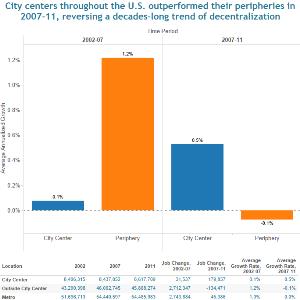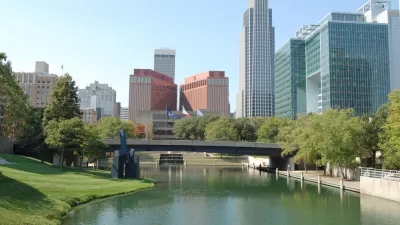For half a century, suburbs surpassed city centers in population and job growth. These economic and demographic trends appear to be reversing. America's cities have grown faster than outlying areas and new research that jobs are coming with them.
For over half a century, American cities were decentralizing, with suburban areas surpassing city centers in both population and job growth. It appears that these economic and demographic tides are now changing. Over the past few years, urban populations in America’s cities have grown faster than outlying areas, and our research shows that jobs are coming with them.
According to a new study, Surging City Center Job Growth, by Joe Cortright of the City Observatory, new census data show that downtown employment centers of the nation's largest metropolitan areas are recording faster job growth than areas located further from the city center. Comparing the aggregate economic performance of urban cores to the surrounding metro periphery over the four years from 2007 to 2011, the researchers found that city centers—which we define as the area within 3 miles of the center of each region’s central business district—grew jobs at a 0.5 percent annual rate while employment in the surrounding peripheral portion of metropolitan areas declined 0.1 percent annually during the same period. When it comes to job growth, city centers are out-performing the surrounding areas in 21 of the 41 metropolitan areas examined. This "center-led" growth represents the reversal of a historic trend of job de-centralization that has persisted for the past half century.

As recently as 2002-2007, peripheral areas were growing much faster (1.2 percent annually) and aggregate job growth was stagnant in urban cores (0.1 percent). While the shift of metropolitan job growth toward services is aiding job centralization, the strong central growth of 2007-11 appears to be driven by the growing competitiveness of central cities relative to peripheral locations.
This analysis shows that city centers had unusually strong job growth relative to peripheral locations in the wake of the Great Recession. Some of the impetus for central city growth comes from the relatively stronger performance of industries that tend to be more centralized, such as finance, entertainment, restaurants, and professional services. The story is not just that job growth in central cities is improving when compared to outlying areas—city centers have also erased their competitive disadvantage relative to peripheral locations.
The strength of city centers appears to be driven by a combination of the growing attractiveness of urban living, and the relatively stronger performance of urban-centered industries (business and professional services, software) relative to decentralized industries (construction, manufacturing) in this economic cycle. While it remains to be seen whether these same patterns continue to hold as the recovery progresses, there are structural forces that suggest the trend of center-led growth will continue.
FULL STORY: Surging City Center Job Growth

Study: Maui’s Plan to Convert Vacation Rentals to Long-Term Housing Could Cause Nearly $1 Billion Economic Loss
The plan would reduce visitor accommodation by 25,% resulting in 1,900 jobs lost.

North Texas Transit Leaders Tout Benefits of TOD for Growing Region
At a summit focused on transit-oriented development, policymakers discussed how North Texas’ expanded light rail system can serve as a tool for economic growth.

Why Should We Subsidize Public Transportation?
Many public transit agencies face financial stress due to rising costs, declining fare revenue, and declining subsidies. Transit advocates must provide a strong business case for increasing public transit funding.

How to Make US Trains Faster
Changes to boarding platforms and a switch to electric trains could improve U.S. passenger rail service without the added cost of high-speed rail.

Columbia’s Revitalized ‘Loop’ Is a Hub for Local Entrepreneurs
A focus on small businesses is helping a commercial corridor in Columbia, Missouri thrive.

Invasive Insect Threatens Minnesota’s Ash Forests
The Emerald Ash Borer is a rapidly spreading invasive pest threatening Minnesota’s ash trees, and homeowners are encouraged to plant diverse replacement species, avoid moving ash firewood, and monitor for signs of infestation.
Urban Design for Planners 1: Software Tools
This six-course series explores essential urban design concepts using open source software and equips planners with the tools they need to participate fully in the urban design process.
Planning for Universal Design
Learn the tools for implementing Universal Design in planning regulations.
City of Santa Clarita
Ascent Environmental
Institute for Housing and Urban Development Studies (IHS)
City of Grandview
Harvard GSD Executive Education
Toledo-Lucas County Plan Commissions
Salt Lake City
NYU Wagner Graduate School of Public Service





























